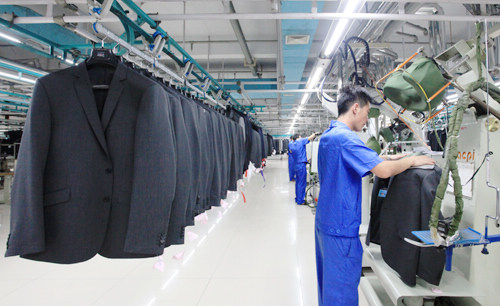|
 |
|
MADE TO ORDER: Workers press suits at a workshop of the Red Collar Group, which takes online orders for tailored suits, in Qingdao, east China's Shandong Province, on July 10 (XINHUA) |
Lei said factories manufacturing relatively low-cost textile and apparel products are being shifted from China to other countries and regions with lower labor costs—including the Philippines, Viet Nam and parts of South Asia.
"Either adapt or perish," said Wang. "The Chinese textile industry needs to be restructured and upgraded for survival—that's for sure. Technology is the key to lower costs, and establishing strong Chinese brands is also vital."
Leading Chinese companies are already exploring ways to add value and creativity to their textile and apparel products and services.
Rubin Lou, Managing Director of Homex Soft Furnishings (Hangzhou) Ltd., came to the exhibition to sell the company's home furnishing products. "We have excellent teams of designers in Britain and we make high-quality products in China based on our own exclusive designs," Lou said.
Since its establishment in December 2006, the company has made its products available in major UK department stores such as John Lewis, he said. It is now looking to enter the U.S. market by partnering with department stores and retailers like JCPenny and Pier 1 Imports.
Zhang Yankai, Vice President of the CNTAC, said China aims to turn itself into a powerhouse in the textile industry by 2020. "Chinese firms must acquire the ability to innovate, create new technologies and develop brands, and they must learn from other countries with more advanced technologies," he said.
Trading with America
The United States is China's second largest export market for textiles and apparel, second only to the EU. Statistics from China's General Administration of Customs show China's textile and apparel exports to the United States reached $33.73 billion in 2010, up 27.7 percent over the previous year, and accounting for 16 percent of China's total textile and apparel exports.
"While China exports large volumes of textile products to the United States, it also imports a lot of raw materials related to textile production from the United States. For instance, cotton and many advanced technologies are imported from the United States," said Zhang.
"Textile trade is an important component of Sino-U.S. trade relations, though it's not always smooth," he said.
The two countries entered a three-year agreement in December 2005 aimed at reining in Chinese textile and apparel exports to the United States after the Multi Fiber Arrangement, also known as the Agreement on Textile and Clothing, which imposed quotas on the volume of clothing developing countries could export to developed countries, expired in January 2005.
In July 2009, the U.S. Department of Commerce announced it would investigate allegations China-made electric blankets were being sold in the United States at unfairly low prices. After the investigation, the United States decided to levy an anti-dumping tariff of up to 174.85 percent on imports of Chinese electric blankets, despite China's opposition to the measure.
The dispute over electric blankets was the first major Sino-U.S. textile trade dispute after U.S. quotas on Chinese textile exports were lifted in January 2005.
But broader friction on trade-related matters between the two economic powerhouses is a common occurrence. While the United States has blamed China for causing job losses in its textile industry, the latter has criticized Washington for resorting to trade protectionism.
Despite the friction, the current trade environment between the two countries is good, the CNTAC's Wang said.
"The most direct pressure on domestic textile enterprises in China comes from rising costs," he said. "What they need to concentrate on is improving techniques and making competitive products that leave little room for doubts or criticism."
(Reporting from New York City) | 